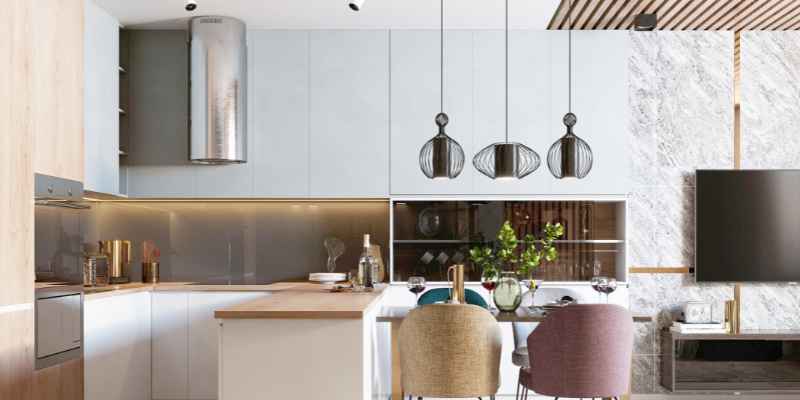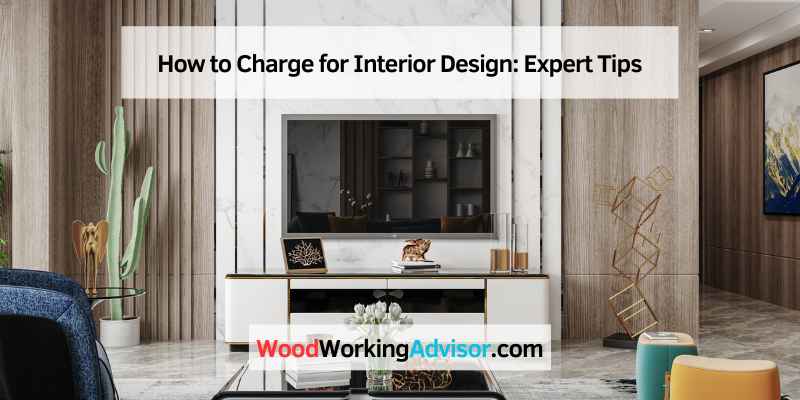To charge for interior design you must consider the size, complexity of the project, cost of labor, furnishings and materials, and project type within the initial two sentences. Interior design is a creative process of shaping living spaces to meet functional and aesthetic needs.
It involves taking into account the client’s preferences, budget, space, and lifestyle to create a unique and comfortable environment. However, charging for interior design services can be tricky. No two projects are the same, and different clients have varying budgets and expectations.
As such, it’s essential to have a pricing strategy that is fair, transparent, and reasonable for both the designer and the client. This article explores various pricing structures used by interior designers, how to calculate interior design costs, and factors that influence pricing.
Determining Your Interior Design Fee
Determining your interior design fee can be a complex undertaking. To calculate interior design costs accurately, consider the size of the area you’re working with, the project’s complexity, labour costs, and furnishings and materials. You can charge clients hourly, flat fees, price per square foot, or a percentage of the project cost.
Factors To Consider For Interior Design Estimate
Determining your interior design fee can be a tricky task. There are various factors that you need to consider to determine your fee. First and foremost, you need to understand the client’s requirements and you must have a clear understanding of the interior design project. Here are some factors that interior designers usually consider when estimating their fee:
- Size of the project area
- Complexity or vision of the project
- Amount of time required to complete the project
- Furnishings and materials needed for the project
- Type of project (residential or commercial)
Once you have considered these factors, you will have a better idea of what your fee will be.
Calculating Your Flat Fee For Interior Design
As an interior designer, one of the pricing structures you can use is the flat fee. A flat fee is a set amount of money that you will charge your client for the entire interior design project. To determine your flat fee, you must follow these steps:
- Estimate the entire cost of the project
- Determine your hourly rate
- Multiply your hourly rate by the estimated amount of time required to complete the project
- Add the cost of any materials that will be used for the project
- Factor in any additional costs such as transportation expenses
Once you have done these calculations, you will have a clear idea of the flat fee you should charge.
Pricing Structures For Interior Designers
Apart from the flat fee structure, there are other pricing structures that interior designers usually follow. These are:
- Hourly rate
- Price per square foot
- Percentage of the project cost
It is up to you to decide which pricing structure works best for you. However, it is important to understand the pros and cons of each pricing structure before deciding on one.
Hourly Rates Of Interior Designers
Interior designers usually charge an hourly rate for their services. The hourly rate can vary depending on the designer’s level of expertise, location, and experience. In general, the hourly rate for interior designers can range anywhere from $50 to $500 per hour.
To ensure that you are charging the right amount, you should research what other interior designers in your area are charging. This will give you a better idea of what the prevailing rates are in your area. Additionally, you should consider your level of experience, the complexity of the project, and the time required to complete the project when determining your hourly rate.

Charging Higher Fees As An Interior Designer
To charge higher fees as an interior designer, you should consider factors such as your experience, expertise, and the demands of the specific project. Your pricing strategy should promote the value of your services, rather than just the cost per hour or project.
Consider charging a flat fee, percentage of the project, or project-based rates to increase your revenue.
As an interior designer, you may be wondering how you can charge higher fees for your services. The answer is simple – by increasing your experience, expertise, and unique selling proposition. With these key elements, you can set yourself apart from other designers and command a higher price for your work. Let’s take a look at each of these areas in more detail.
Increasing Your Experience And Expertise
One of the easiest ways to charge higher fees as an interior designer is by increasing your experience and expertise. The more experience you have, the more confident you will be in your work, and the more value you can provide to your clients. Consider taking on a variety of projects to expand your skills and knowledge. By doing so, you can become an expert in niche areas such as sustainable design, minimalist interiors, or historic preservation.
Continuing Education In Interior Design
Continuing education is another key way to increase your expertise and stand out in the industry. There are many courses, seminars, and workshops available to help you stay up-to-date with the latest trends and techniques. Consider enrolling in online or in-person classes to expand your knowledge base. Seek out design organizations that provide industry-specific certifications, such as the National Council for Interior Design Qualification (NCIDQ).
Becoming A Registered Interior Designer
Becoming a registered interior designer can also lead to higher fees. Being registered shows that you have met specific educational and experiential requirements and have passed a qualifying exam. Being registered also gives you the legal ability in some states to use the title “interior designer.”
Finding Your Unique Selling Proposition
Finally, finding your unique selling proposition can differentiate you from other designers. Determine what sets you apart based on your experience, expertise, and design style. This could be a niche service or a unique approach to the design process. Focus on this unique aspect of your business and market it to prospective clients.
In conclusion, charging higher fees as an interior designer requires a combination of increasing your experience and expertise, continuing education, becoming a registered interior designer, and finding your unique selling proposition. By investing in these areas, you can set yourself apart from other designers and command higher fees for your services.
Interior Design Software To Help Calculate Cost
Calculating the cost of interior design services can be difficult, but using interior design software can help. By taking into account the size of the area, the project’s complexity, cost of labor, and materials, designers can accurately estimate the cost of their services.
One of the biggest challenges interior designers face is how to charge for their services. While some designers opt for hourly rates, others charge on a per-project basis or a flat fee. Whichever method you choose, you need to ensure that you are charging enough to cover your costs, including time and materials. This is where interior design software comes in handy. Here are some of the most popular software options that can help you calculate the cost of your interior design project.
HomeByMe
HomeByMe is a 3D interior design software that allows you to create floor plans and design rooms in 3D. With HomeByMe, you can experiment with different layouts, furniture, and decor to create the perfect design for your client. The software also has a built-in cost estimator that can help you calculate the cost of your project based on the materials and labor you plan to use.
SketchUp
SketchUp is a 3D modeling software that is popular among architects, engineers, and interior designers. With SketchUp, you can create detailed 3D models of your interior design project, including furniture, lighting, and decor. The software also has a cost estimator feature that can help you calculate the cost of your project based on your design.
AutoCAD
AutoCAD is a drafting software that is widely used in the architecture and interior design industries. With AutoCAD, you can create 2D and 3D drawings of your interior design project, including floor plans, elevations, and sections. The software also has features that allow you to calculate the cost of your project based on the materials and labor you plan to use.
Autodesk Revit
Autodesk Revit is a building information modeling (BIM) software that is used by architects, engineers, and interior designers. With Revit, you can create detailed 3D models of your interior design project, including furniture, lighting, and decor. The software also has a cost estimating feature that can help you calculate the cost of your project based on your design.
In conclusion, interior design software can be a valuable tool for helping you calculate the cost of your interior design projects. Whether you’re a freelance designer or part of a design firm, using software like HomeByMe, SketchUp, AutoCAD, or Autodesk Revit can help you create more accurate cost estimates and ensure that you’re charging enough to cover your expenses.

Frequently Asked Questions For How To Charge For Interior Design
How Do You Calculate Cost Of Interior Design?
To calculate the cost of interior design, consider the size of the area, complexity of the project, cost of labour, furnishings and material, and project type. You can charge hourly, flat fee, price per square foot, percentage of the project, commission only, or hybrid.
A flat fee or hourly rate is appropriate for small projects. Estimate the number of hours required for a particular phase.
What Do Interior Designers Usually Charge?
Interior designers typically charge either a flat fee or an hourly rate for their services. The cost of hiring an interior designer varies depending on the scope of the project, the designer’s experience and expertise, and the location. The project’s size, complexity, and vision are crucial factors in determining the interior design estimate.
Furnishings and materials, as well as labor costs, also impact the final cost. It’s best to consult with an interior designer to determine the specific fees for your project.
How Do Interior Designers Price?
Interior designers typically charge either a flat fee or an hourly rate for their services. The cost is determined by factors such as the size of the area, the project’s complexity or vision, cost of labor, furnishings and material, and project type.
Some interior designers may charge a percentage of the project cost or commission only.
How Do You Calculate Flat Fee For Interior Design?
To calculate a flat fee for interior design, you need to consider the size of the area, the project’s complexity, the cost of labor, furnishings and materials, and project type. Registered interior designers typically choose from various fee structures such as hourly, flat fee, percentage of project, commission only, or hybrid.
A flat fee is appropriate for small projects, while hourly rates are ideal for larger, more intricate projects. Additionally, estimating the number of hours needed for each phase of the project can help establish fees.
Conclusion
As an interior designer, knowing how to charge for your services is crucial to the success of your business. By considering factors such as the size of the area, the project’s vision, cost of labor, and furnishings and material needed, you will be able to calculate the appropriate cost for your clients.
Remember to choose a pricing structure that works best for you and to communicate clearly with your clients about your fees and service offerings. By following these guidelines, you can set yourself up for success in the competitive world of interior design.


